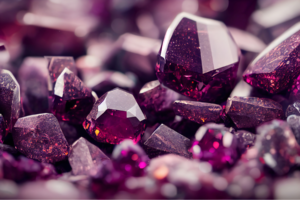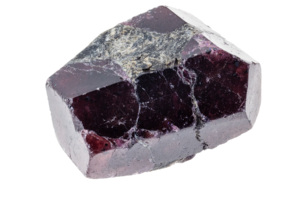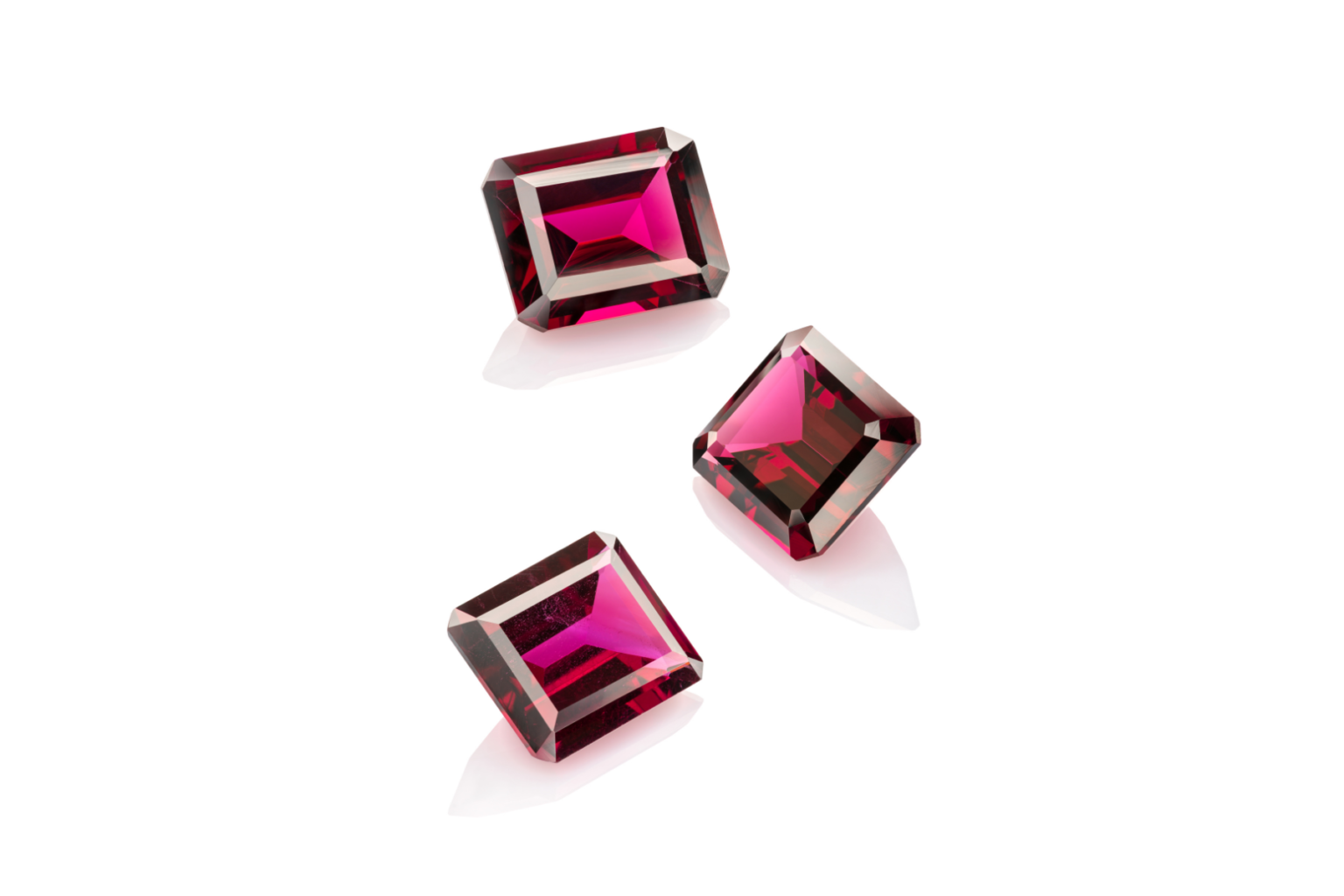What is garnet?
Garnet is a group of minerals that includes several different species, all of which share a similar crystal structure and chemical composition. The most commonly known species of garnet include almandine, pyrope, spessartine, andradite, grossular, and uvarovite. Garnet is typically found in a range of colors, including red, brown, green, yellow, and black.
Garnet has been used for centuries as a gemstone, and has a rich history and symbolism in many cultures. In ancient times, it was believed to have protective properties and was often worn as an amulet or talisman. It has also been used in jewelry-making throughout history, and remains a popular choice for rings, necklaces, and earrings today.
In addition to its use as a gemstone, garnet is also used in a range of industrial and scientific applications. It is a common abrasive material, used for sandpaper, grinding wheels, and other cutting tools. It is also used in water filtration systems, as it has a high affinity for removing impurities from water.
In terms of its metaphysical properties, garnet is believed to have a range of healing properties for both physical and emotional well-being. It is associated with the root chakra, and is believed to promote feelings of grounding, stability, and security. It is also believed to promote feelings of passion, motivation, and energy, and can be helpful for those who feel stuck or stagnant in their lives.
This is the birthstone for January.
The Appearance of Garnet
The appearance of garnet can vary depending on the specific species and variety. Generally, garnet is a hard, dense mineral that is found in a range of colors, including red, brown, green, yellow, and black. The most common color of garnet used in jewelry is a deep red or reddish-brown, which is often referred to as “garnet red”.
Garnet has a vitreous or glassy luster and a range of transparency, from completely transparent to opaque. Its crystal structure is typically isometric, meaning that its crystal faces are symmetrical and geometric. Garnet can be found in a range of shapes, including rounded or angular crystals, and can be faceted or cut into a variety of shapes for use in jewelry.
In addition to its natural variations in color and transparency, garnet can also display unique optical properties. For example, some varieties of garnet exhibit a phenomenon called “color change”, in which the gemstone appears to change color depending on the lighting conditions. Other varieties of garnet may exhibit asterism, or the appearance of a star-shaped pattern when viewed in certain lighting conditions.
 What are the properties of garnet?
What are the properties of garnet?
Garnet is believed to have a range of physical and emotional properties that can support well-being and spiritual connection. Here are some of the most commonly known properties of garnet:
- Grounding and stabilizing: Garnet is associated with the root chakra, which is located at the base of the spine and is associated with grounding, stability, and security. Garnet is believed to promote feelings of stability and grounding, helping to balance and center the body and mind.
- Energizing and motivating: Garnet is also believed to have energizing and motivating properties, promoting feelings of passion, drive, and motivation. It is believed to support those who are feeling stagnant or stuck in their lives, helping to provide the energy and enthusiasm needed to move forward.
- Protective: Garnet is sometimes used for protection, as it is believed to have a grounding and stabilizing energy that can help to ward off negative energies or entities. It is also believed to promote feelings of safety and security, helping to calm anxiety and fear.
- Healing: Garnet is believed to have a range of physical healing properties, such as promoting circulation, supporting the immune system, and alleviating inflammation. It is also believed to be helpful for those who suffer from menstrual or hormonal imbalances, as it is believed to have a regulating effect on the body’s systems.
- Emotional support: Garnet is also believed to promote emotional well-being, helping to alleviate feelings of depression, anxiety, and other emotional imbalances. It is believed to promote feelings of self-confidence and courage, and can be helpful for those who are struggling with grief or loss.
 What is the chakra of garnet?
What is the chakra of garnet?
The chakra of garnet can vary depending on the specific variety and color of garnet, but in general, garnet is most commonly associated with the root chakra. The root chakra, also known as the base chakra, is located at the base of the spine and is associated with grounding, stability, and security. It is believed to be the foundation of the body’s energy system, providing a stable and secure base from which all other chakras can operate.
Garnet is believed to have a grounding and stabilizing energy that can help to balance and align the root chakra. It is believed to promote feelings of stability, safety, and security, helping to calm anxiety and fear. It is also believed to promote feelings of passion, motivation, and energy, helping to support those who are feeling stuck or stagnant in their lives.
While garnet is most commonly associated with the root chakra, some varieties of garnet may also be associated with other chakras. For example, some pink or green varieties of garnet may be associated with the heart chakra, which is located at the center of the chest and is associated with love, compassion, and emotional balance.
Overall, garnet is a powerful and versatile gemstone with a range of properties that can support well-being and spiritual connection. Whether you are drawn to its grounding and stabilizing energy, its energizing and motivating properties, or its association with the root chakra, garnet is a meaningful and symbolic gemstone that can be used in a variety of ways to promote overall well-being and spiritual connection.
How can garnet be used to heal?
Garnet is believed to have a range of physical and emotional healing properties that can support well-being and spiritual connection. Here are some of the ways in which garnet can be used for healing:
- Wear garnet as jewelry: One of the easiest ways to benefit from the healing properties of garnet is to wear it as jewelry. Garnet can be set in rings, necklaces, and earrings, and can be worn on the skin or close to the body to promote its healing energy.
- Place garnet on the body: Garnet can also be placed directly on the body in areas where healing is needed. For example, a small piece of garnet can be placed on the stomach to support the digestive system, or on the lower back to support the root chakra and promote grounding and stability.
- Meditate with garnet: Garnet can be used in meditation practices to promote feelings of grounding and stability. Simply hold a piece of garnet in your hand or place it nearby during your meditation practice to promote its healing energy.
- Use garnet in crystal healing practices: Garnet can be used in crystal healing practices to support a range of physical and emotional imbalances. For example, it can be placed on the sacral chakra to support emotional balance and well-being, or on the heart chakra to promote feelings of love and compassion.
Overall, garnet is a versatile and powerful gemstone with a range of healing properties for both physical and emotional well-being. Whether you choose to wear it as jewelry, place it on the body, or use it in crystal healing practices, garnet is a meaningful and symbolic gemstone that can support overall well-being and spiritual connection.
Where did garnet originate from?
Garnet is a widely distributed mineral and can be found in many parts of the world. It has been mined for thousands of years and has a rich history of use in jewelry-making and other decorative arts.
Some of the most well-known sources of garnet include:
- India: India has been a major source of garnet for centuries, and is known for producing high-quality specimens with a range of colors.
- United States: Garnet can be found in many parts of the United States, including Idaho, Montana, and North Carolina.
- Madagascar: Madagascar is known for its unique and unusual varieties of garnet, including the green andradite variety known as “demantoid”.
- Russia: Russia is a well-known source of high-quality garnet, particularly the deep red pyrope variety.
- Australia: Australia is a relatively new source of garnet, but has been producing high-quality specimens with a range of colors, including green, yellow, and orange.
The History of Garnet
Garnet has a rich and fascinating history that dates back thousands of years. It has been used for a variety of purposes throughout history, including as a decorative stone, a symbol of power and authority, and a protective talisman.
In ancient times, garnet was highly valued for its beauty and durability. It was often used in jewelry-making and other decorative arts, and was considered a symbol of wealth and status. Garnet was also believed to have protective properties, and was often worn as an amulet or talisman to ward off negative energies or entities.
In ancient Greece and Rome, garnet was associated with the god of war, and was often carved into figures of soldiers or warriors. It was also believed to have healing properties, and was used to treat a range of ailments, including fever, inflammation, and infection.
During the Middle Ages, garnet continued to be a popular gemstone, and was often used in religious art and architecture. It was also believed to have protective properties, and was sometimes used to make armor and other protective gear.
In the 19th century, garnet experienced a resurgence in popularity, particularly in Euro pe and the United States. It was often used in Victorian-era jewelry, and was considered a symbol of love and devotion. It was also believed to have healing properties, and was used in a range of folk remedies and natural medicines.
pe and the United States. It was often used in Victorian-era jewelry, and was considered a symbol of love and devotion. It was also believed to have healing properties, and was used in a range of folk remedies and natural medicines.
Today, garnet remains a popular and versatile gemstone, valued for its beauty and symbolic meaning. It is often used in jewelry-making, decorative arts, and crystal healing practices, and is still believed to have a range of physical and emotional healing properties. Its rich history and symbolism make it a meaningful and significant gemstone that continues to captivate and inspire people all over the world.
Summary
Garnet is a group of minerals with a range of colors and appearances, commonly used in jewelry-making, decorative arts, and crystal healing practices. It has a rich history dating back thousands of years and has been valued for its beauty, durability, and symbolic meaning. Garnet has been associated with various gods, protective properties, and healing benefits in different cultures and time periods. Today, it continues to be a popular and versatile gemstone used to promote physical and emotional well-being, and its rich history and symbolism make it a meaningful and significant gemstone.

